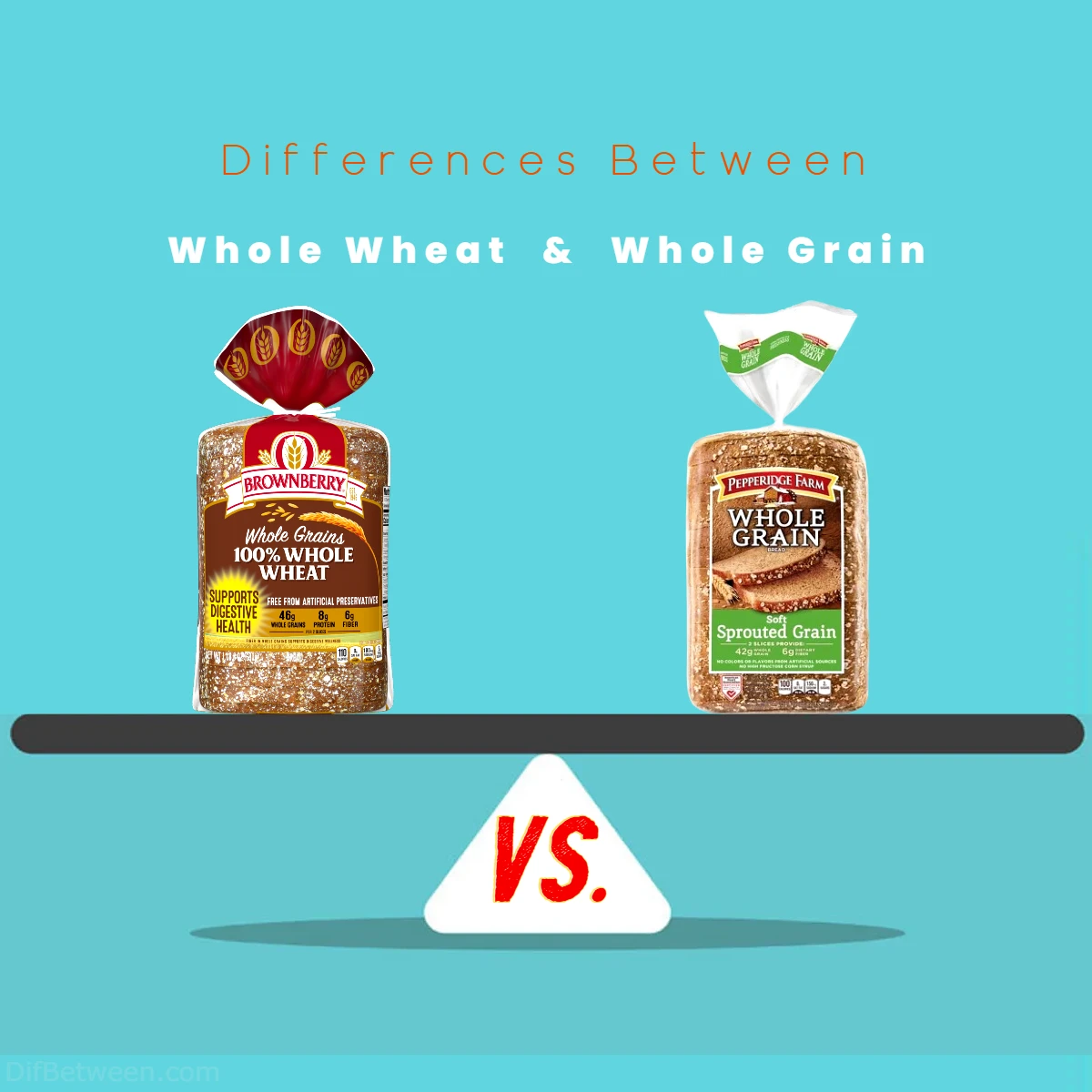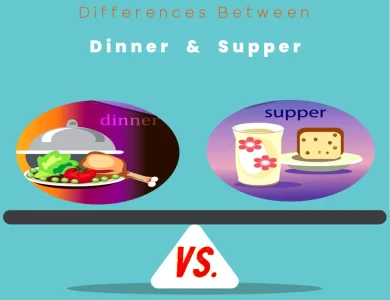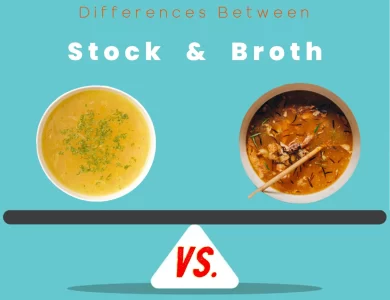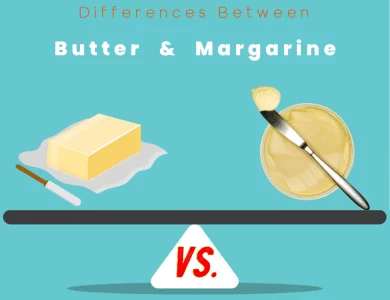
| Aspect | Whole Wheat | Whole Grain |
|---|---|---|
| Primary Source | Wheat | Various grains (e.g., oats, barley, rice) |
| Nutritional Content | Similar in fiber, vitamins, and minerals | Similar in fiber, vitamins, and minerals |
| Glycemic Index | Can vary, generally higher GI | Can vary, some options with lower GI |
| Gluten Content | Contains gluten | May contain gluten (depends on grains used) |
| Taste and Texture | Nutty and hearty | Diverse flavors and textures |
| Culinary Versatility | Suitable for baking, cooking, and more | Suitable for a variety of dishes |
| Dietary Considerations | Suitable for most diets | Suitable for most diets, gluten-free options available |
| Environmental Impact | Wheat is a widespread crop with ongoing sustainability efforts | Some whole grains require less water and land, promoting resource efficiency |
| Typical Products | Whole wheat bread, whole wheat pasta, whole wheat flour | Brown rice, quinoa, oats, barley, whole grain bread, whole grain pasta |
| Notable Health Benefits | Fiber supports digestion and satiety | Diverse nutrient profiles offer a wide range of vitamins and minerals |
| Ideal For | Those who enjoy wheat-based products and are not gluten-sensitive | Individuals seeking variety in their diet, including gluten-sensitive individuals |
| Key Factors to Consider | Glycemic index, gluten sensitivity, taste preferences, culinary diversity | Glycemic index, dietary diversity, gluten sensitivity, sustainability |
| Common Uses | Bread, pasta, flour, baked goods | Rice dishes, grain bowls, salads, baked goods (using various whole grain flours) |
Imagine the delightful aroma of freshly baked bread, the comforting embrace of a warm bowl of oatmeal, and the satisfying crunch of nutty whole grain crackers. It’s a culinary adventure that leads to a healthier you.but how do you navigate this vibrant landscape of whole wheat and whole grain? Well, that’s precisely what we’re here to unravel.
Differences Between Whole Wheat and Whole Grain
The main differences between Whole Wheat vs Whole Grain lie in their primary sources and nutritional profiles. Whole wheat specifically pertains to products derived from wheat, retaining the entire wheat kernel, while whole grain encompasses a wider array of grains like oats, barley, and quinoa. Nutritionally, both offer similar benefits in terms of dietary fiber, vitamins, and minerals, with minor variations based on the specific grain type. Additionally, individuals with gluten sensitivity should note that whole wheat contains gluten, whereas many whole grain options are naturally gluten-free. These distinctions empower you to make informed dietary choices that align with your preferences and dietary requirements.
1. The Basics: Whole Wheat and Whole Grain Defined
Let’s start by defining these terms so we’re all on the same page.
Whole Wheat: Whole wheat refers specifically to wheat products. When a product is labeled as “whole wheat,” it means that the wheat used to make it has not undergone significant processing. Whole wheat flour is made by grinding the entire wheat kernel, including the bran, germ, and endosperm. This means you’re getting all the parts of the wheat grain in your food.
Whole Grain: Whole grain, on the other hand, is a broader category that encompasses all grains and cereals. When a product is labeled as “whole grain,” it means that the entire grain kernel has been used, just like with whole wheat. This includes the bran, germ, and endosperm, ensuring that you get all the nutritional goodness these grains have to offer.
2. Nutritional Value: What’s Inside?
Now that we understand the basic definitions, let’s take a closer look at the nutritional differences between whole wheat and whole grain products.
Table 1: Nutritional Comparison of Whole Wheat and Whole Grain
| Nutritional Component | Whole Wheat (per 100g) | Whole Grain (per 100g) |
|---|---|---|
| Calories | 340 kcal | 320 kcal |
| Carbohydrates | 72g | 67g |
| Dietary Fiber | 10.7g | 9.8g |
| Protein | 12.6g | 11.8g |
| Total Fat | 1.9g | 2.8g |
| Vitamins and Minerals | Varies, including B vitamins and iron | Varies, including B vitamins and iron |
Whole Wheat: Whole wheat is primarily associated with products made from wheat grains, such as whole wheat bread, pasta, and flour. It is a good source of dietary fiber, providing about 10.7 grams per 100 grams of whole wheat flour. This fiber content aids in digestion, helps maintain steady blood sugar levels, and supports heart health.
Whole wheat also contains essential nutrients like B vitamins and iron, although the exact amounts can vary depending on factors like soil quality and processing methods.
Whole Grain: Whole grain products can encompass a wide range of grains, including wheat, oats, barley, rice, and more. In terms of nutritional value, whole grains are quite similar to whole wheat. They offer a similar fiber content (around 9.8 grams per 100 grams) and provide essential vitamins and minerals, including B vitamins and iron.
The small differences in nutritional content between whole wheat and whole grain products are generally insignificant and can be attributed to the natural variations in different grain types.
3. Dietary Fiber: Gut Health and Beyond
Dietary fiber is a critical component of both whole wheat and whole grain foods, and it plays a vital role in promoting overall health. Let’s explore how these two options compare in terms of their fiber content and the benefits they offer.
Table 2: Dietary Fiber Content in Various Whole Wheat and Whole Grain Products
| Product | Dietary Fiber (per 100g) |
|---|---|
| Whole Wheat Bread | 6.6g |
| Whole Grain Bread | 7.9g |
| Whole Wheat Pasta | 3.2g |
| Whole Grain Pasta | 4.2g |
| Whole Wheat Flour | 10.7g |
| Whole Grain Flour (e.g., whole wheat, whole oats) | 9.8g |
Fiber Content: When comparing specific products like whole wheat bread and whole grain bread, you’ll notice that whole grain options tend to have slightly higher fiber content. This extra fiber can be beneficial for digestive health, as it supports regular bowel movements, prevents constipation, and may lower the risk of developing gastrointestinal disorders like diverticulosis.
Beyond Digestion: Dietary fiber offers more than just digestive benefits. It can also help control appetite and assist in weight management by promoting a feeling of fullness. Additionally, a high-fiber diet is associated with a reduced risk of chronic diseases, such as heart disease, type 2 diabetes, and certain types of cancer.
4. The Glycemic Index: Impact on Blood Sugar
The glycemic index (GI) is a measure of how quickly carbohydrates in a food raise blood sugar levels. Foods with a high GI can cause rapid spikes and crashes in blood sugar, which may not be ideal for people looking to maintain steady energy levels and control their appetite. Let’s explore how whole wheat and whole grain products compare in terms of their glycemic index.
Table 3: Glycemic Index of Whole Wheat and Whole Grain Products
| Product | Glycemic Index (GI) |
|---|---|
| Whole Wheat Bread | 71 (high GI) |
| Whole Grain Bread | 51 (medium GI) |
| Whole Wheat Pasta | 37 (low GI) |
| Whole Grain Pasta | 45 (medium GI) |
| Whole Wheat Flour | Varies |
| Whole Grain Flour (e.g., whole wheat, whole oats) | Varies |
Glycemic Index Rankings: Whole wheat bread has a relatively high glycemic index, which means it can cause a rapid increase in blood sugar levels after consumption. On the other hand, whole grain bread has a lower GI, indicating a slower and more gradual rise in blood sugar.
When we look at pasta, whole wheat pasta has a lower GI than whole grain pasta, making it a better choice for those concerned about blood sugar control.
Factors Affecting GI: It’s important to note that the glycemic index can vary based on factors like cooking time and processing. Whole wheat flour and whole grain flour can have varying GIs depending on how they are used in recipes and the specific grains involved. Cooking pasta “al dente” can also lower its GI.
5. Gluten Content: Considerations for Gluten Sensitivity
Gluten is a protein found in wheat, rye, and barley. For individuals with celiac disease or non-celiac gluten sensitivity, avoiding gluten is essential. Let’s examine how whole wheat and whole grain products differ in terms of gluten content and suitability for those with gluten-related concerns.
Table 4: Gluten Content in Whole Wheat and Whole Grain Products
| Product | Gluten Content |
|---|---|
| Whole Wheat Bread | Contains gluten |
| Whole Grain Bread | May contain gluten depending on grains used |
| Whole Wheat Pasta | Contains gluten |
| Whole Grain Pasta | May contain gluten depending on grains used |
| Whole Wheat Flour | Contains gluten |
| Whole Grain Flour (e.g., whole wheat, whole oats) | May contain gluten depending on grains used |
Gluten Content Clarified: Whole wheat products, including bread, pasta, and flour, are made from wheat, which inherently contains gluten. Therefore, all whole wheat products contain gluten and are not suitable for those with gluten-related disorders.
Whole grain products can be a bit more complex. While some whole grain options like brown rice, quinoa, and oats are naturally gluten-free, others like whole wheat and whole barley contain gluten. It’s crucial for individuals with gluten sensitivity or celiac disease to choose whole grain products made from gluten-free grains and processed in a gluten-free environment.
6. Taste and Texture: What’s Your Preference?
Taste and texture are subjective factors that play a significant role in determining our food choices. Some people have strong preferences for the flavor and mouthfeel of whole wheat, while others prefer the diversity of whole grain options. Let’s explore these aspects in more detail.
Whole Wheat: Whole wheat products often have a distinctive nutty and slightly bitter flavor compared to their refined counterparts. The texture can be denser, with a hearty and rustic quality that some people find appealing. Whole wheat bread, for instance, may have a coarser crumb and a darker color due to the presence of bran.
Whole Grain: Whole grain products encompass a wide variety of grains, each with its unique taste and texture. Brown rice has a slightly nutty flavor, quinoa is known for its mild and nutty taste, and oats have a creamy texture. This diversity allows for a range of culinary possibilities, catering to different taste preferences.
7. Culinary Versatility: Cooking with Whole Wheat and Whole Grain
The versatility of whole wheat and whole grain products in the kitchen is an essential consideration for many home cooks. Let’s explore how these options fare in various culinary applications.
Table 5: Culinary Versatility of Whole Wheat and Whole Grain Products
| Culinary Application | Whole Wheat Products | Whole Grain Products |
|---|---|---|
| Baking (Bread, Muffins, etc.) | Suitable, provides a hearty texture | Suitable, offers diverse flavors and textures |
| Cooking (Pasta, Rice, etc.) | Suitable, but may have a slightly different texture | Suitable, with a variety of grains to choose from |
| Breakfast (Oatmeal, Cereal, etc.) | Suitable, whole wheat flakes and granola are options | Suitable, with options like steel-cut oats and granola |
| Snacking (Crackers, Chips, etc.) | Suitable, whole wheat crackers and chips are available | Suitable, with whole grain options in the snack aisle |
| Desserts (Cookies, Brownies, etc.) | Suitable, whole wheat flour can be used in recipes | Suitable, with whole grain flours available for baking |
Baking: Both whole wheat and whole grain flours can be used in baking, but the choice depends on the desired flavor and texture. Whole wheat flour imparts a robust and slightly nutty taste, while whole grain flours introduce a broader range of flavors and textures.
Cooking: In savory dishes like pasta and rice-based recipes, both whole wheat and whole grain options are suitable. While whole wheat pasta may have a different texture, whole grains like brown rice, quinoa, and farro offer unique flavors and textures to enhance your dishes.
Breakfast: For breakfast lovers, whole wheat and whole grain options abound. Whole wheat flakes, granola, and oatmeal are popular choices for a wholesome morning meal. Whole grain alternatives like steel-cut oats and muesli add variety to your breakfast routine.
Snacking: When it comes to snacking, both whole wheat and whole grain options are available in the form of crackers, chips, and more. These products offer a healthier alternative to their refined counterparts, making them suitable for mindful snacking.
Desserts: Yes, you can even indulge your sweet tooth with whole wheat and whole grain options. Whole wheat flour can be used in cookie and brownie recipes, while whole grain flours like oat flour and barley flour can add unique flavors to your baked goods.
Whole Wheat or Whole Grain: Which One is Right Choose for You?
When it comes to making healthy food choices, understanding the difference between whole wheat and whole grain can make a significant impact on your diet and overall well-being. Both options have their unique qualities, and choosing the right one for you depends on various factors. In this guide, we’ll explore the characteristics of whole wheat and whole grain and help you determine which one aligns better with your dietary preferences and health goals.
1. Whole Wheat: The Wheat-Centric Option
Whole Wheat Defined: Whole wheat is a specific type of grain, namely wheat, in its unrefined form. It includes all parts of the wheat kernel—the bran, germ, and endosperm—making it a nutritionally dense choice.
Nutritional Highlights of Whole Wheat:
- Fiber: Whole wheat is a good source of dietary fiber, aiding in digestion and promoting a sense of fullness.
- B Vitamins: It contains essential B vitamins like folate, niacin, and riboflavin, which are vital for energy production and overall health.
- Minerals: Whole wheat provides minerals such as iron, magnesium, and selenium, which play essential roles in various bodily functions.
Who Should Choose Whole Wheat? Whole wheat is an excellent choice for those who prefer the nutty flavor and slightly denser texture it offers. It’s ideal for individuals who enjoy the taste of wheat-based products like whole wheat bread, pasta, and flour. Additionally, if you are not gluten-sensitive and want to maintain a diet rich in B vitamins and minerals, whole wheat can be a beneficial choice.
2. Whole Grain: The Diverse and Inclusive Option
Whole Grain Defined: Whole grain is a broader category encompassing all grains and cereals in their unprocessed form. This includes wheat, oats, barley, rice, quinoa, and more. Whole grain products use the entire grain kernel, ensuring maximum nutritional value.
Nutritional Highlights of Whole Grain:
- Diverse Nutrients: Whole grains vary in nutrient profiles, offering a wide range of vitamins, minerals, and antioxidants.
- Fiber: Like whole wheat, whole grains are a good source of dietary fiber, supporting digestive health and overall well-being.
- Variety: Whole grain options provide a diverse array of flavors and textures, making them suitable for various culinary applications.
Who Should Choose Whole Grain? Whole grain is an excellent choice for those seeking variety in their diet. If you enjoy experimenting with different grains like brown rice, quinoa, oats, and barley, whole grain products offer a world of culinary possibilities. Additionally, whole grain can be a suitable option for individuals with gluten sensitivity, as there are many gluten-free whole grains available, contributing to a balanced and inclusive diet.
3. Dietary Goals: Weight Management and Blood Sugar Control
Weight Management:
- Whole Wheat: Its fiber content can help you feel full, reducing the likelihood of overeating and supporting weight management.
- Whole Grain: Whole grains offer a similar satiety effect due to their fiber content, making them suitable for weight-conscious individuals.
Blood Sugar Control:
- Whole Wheat: Some whole wheat products may have a higher glycemic index (GI), potentially causing rapid spikes in blood sugar levels.
- Whole Grain: Whole grains often include options with lower GI values, making them a better choice for blood sugar control. However, GI can vary, so it’s essential to check the specific grain’s GI value.
4. Gluten Sensitivity: Considerations for Gluten-Free Diets
Whole Wheat:
- Contains Gluten: Whole wheat is a gluten-containing grain, making it unsuitable for individuals with celiac disease or non-celiac gluten sensitivity.
Whole Grain:
- Gluten-Free Options: Many whole grains, such as brown rice, quinoa, oats (certified gluten-free), and amaranth, are naturally gluten-free and safe for those with gluten-related disorders.
5. Taste Preferences and Culinary Versatility
Taste Preferences:
- Whole Wheat: Offers a nutty and slightly bitter flavor, with a denser texture.
- Whole Grain: Provides a diverse range of flavors and textures, allowing for culinary creativity.
Culinary Versatility:
- Whole Wheat: Suitable for baking, cooking, and everyday meals, offering a hearty and wholesome quality.
- Whole Grain: Ideal for various culinary applications, from salads to grain bowls, providing a broad spectrum of flavors and textures to explore.
6. Environmental Impact: A Sustainable Choice
Whole Wheat:
- Widespread Crop: Wheat is a staple crop grown globally, contributing to food accessibility.
- Environmental Improvements: Ongoing efforts aim to enhance wheat cultivation practices, including resource management.
Whole Grain:
- Resource Efficiency: Many whole grains, such as oats and barley, require less water and land compared to some other crops.
- Crop Diversity: The cultivation of various whole grains promotes crop rotation, improving soil health and reducing the need for chemical fertilizers.
7. Informed Choices: Reading Food Labels
To make informed choices between whole wheat and whole grain products, pay attention to food labels:
Ingredients List:
- Look for “whole wheat” or “whole grain” listed as primary ingredients.
- Be cautious of products labeled “wheat” without specifying “whole wheat.”
Whole Grain Stamp:
- Some products carry a “Whole Grain Stamp” indicating compliance with whole grain criteria.
Fiber Content:
- Examine the nutrition facts panel for dietary fiber content, a hallmark of whole grain and whole wheat products.
Glycemic Index Information:
- Some manufacturers provide GI values, which can be crucial for blood sugar control.
Gluten-Free Certification:
- For gluten-sensitive individuals, seek products with gluten-free certification or “certified gluten-free” labels.
Conclusion: Making the Right Choice
In the whole wheat vs. whole grain debate, there’s no one-size-fits-all answer. Your choice should reflect your dietary preferences, health objectives, and any dietary restrictions you may have. Both whole wheat and whole grain products offer valuable nutritional benefits and culinary opportunities.
FAQs
The fundamental difference lies in their sources. Whole wheat pertains exclusively to wheat products, while whole grain encompasses all grains and cereals in their unprocessed form, offering a broader variety of options.
Yes, both offer comparable nutritional benefits, including dietary fiber, vitamins, and minerals. The small variations depend on the specific grain type but are generally insignificant.
Yes, there can be differences in GI. Whole wheat products may have a higher GI, potentially leading to quicker blood sugar spikes. Whole grains, in contrast, include options with lower GI values, which can be better for blood sugar control.
Many whole grains are naturally gluten-free, making them safe for individuals with gluten sensitivity. However, it’s crucial to choose grains processed in a gluten-free environment and certified as gluten-free to avoid cross-contamination.
Yes, they do. Whole wheat offers a nuttier and denser texture, while whole grains provide a diverse range of flavors and textures, allowing for culinary creativity.
Yes, there are environmental factors to consider. Some whole grains, such as oats and barley, require less water and land compared to other crops, contributing to resource efficiency and sustainable agriculture.
Reading food labels is essential. Look for “whole wheat” or “whole grain” as primary ingredients, check for Whole Grain Stamps, and examine fiber content and glycemic index information when available.
Absolutely! Both options offer valuable nutritional benefits and can be incorporated into a well-rounded diet, allowing you to enjoy a wide range of flavors and health advantages.
Read More:
Contents
- Differences Between Whole Wheat and Whole Grain
- 1. The Basics: Whole Wheat and Whole Grain Defined
- 2. Nutritional Value: What’s Inside?
- 3. Dietary Fiber: Gut Health and Beyond
- 4. The Glycemic Index: Impact on Blood Sugar
- 5. Gluten Content: Considerations for Gluten Sensitivity
- 6. Taste and Texture: What’s Your Preference?
- 7. Culinary Versatility: Cooking with Whole Wheat and Whole Grain
- Whole Wheat or Whole Grain: Which One is Right Choose for You?
- 1. Whole Wheat: The Wheat-Centric Option
- 2. Whole Grain: The Diverse and Inclusive Option
- 3. Dietary Goals: Weight Management and Blood Sugar Control
- 4. Gluten Sensitivity: Considerations for Gluten-Free Diets
- 5. Taste Preferences and Culinary Versatility
- 6. Environmental Impact: A Sustainable Choice
- 7. Informed Choices: Reading Food Labels
- Conclusion: Making the Right Choice
- FAQs






